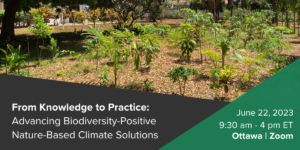
Advancing climate solutions that sustainably use ecosystems and preserve biodiversity is critical to help communities become more resilient to the impacts of climate change.
Nature-based Solutions (NbS) that conserve, restore, and sustainably use biodiversity and ecosystems hold promise in helping people adapt to the adverse effects of climate change. But it is often a challenge to achieve measurable gains for biodiversity and ecosystem functioning while also achieving wins for society and climate adaptation.
From Knowledge to Practice: Advancing Biodiversity-Positive Nature-Based Climate Solutions for Adaptation
On June 22, 2023, Aga Khan Foundation Canada (AKFC), the International Institute for Sustainable Development (IISD) (under the Nature for Climate Adaptation Initiative), and Global Affairs Canada (GAC) welcomed Canadian and international participants to the Delegation of the Ismaili Imamat in Ottawa for a hybrid event on biodiversity-positive, nature-based climate solutions.
This interactive session focused on maximizing benefits for biodiversity and ecosystem health through nature-based climate solutions (NbCS). The session featured presentations and breakout discussions with experienced practitioners, including:
- Anita Miya, Head of Environment Planning, Aga Khan Agency for Habitat (AKAH) India
Watch her presentation: Biodiversity and Ecosystem-Based Climate Change Adaptation project, Gujarat, India
- Nicholas Macfarlane, Senior Scientist and Programme Manager, Centre for Science and Data, International Union for Conservation of Nature (IUCN)
Watch his presentation: Species Threat Abatement and Recovery (STAR) Metric
- Anil Gupta, Senior Environment Specialist, GAC, and Paul Stewart, Global Coffee Director, TechnoServe
Watch their presentation: Coffee Climate Resilience in Ethiopia – the Challenges and Opportunities using NbS
- Janet Sumner, Executive Director, Wildlands League
Watch her presentation: Nature Connectivity Project
The session was followed by a community of practice meeting focusing on NbBCS and biodiversity, led by GAC.
Kiersten Eyes, AKFC’s Director of Public Engagement and Resource Mobilization, opened the session by welcoming participants – both in-person and virtually – to the Delegation. Kiersten noted that AKFC, IISD, and GAC had previously co-convened the event “Advancing Gender-Responsive Nature-Based Climate Solutions”, which focused on advancing gender equality and inclusion in local-level adaptation initiatives. She noted that the focus on biodiversity-positive considerations of NbS was another critical aspect of addressing biodiversity loss and strengthening climate resilience through an inclusive, rights-based, and biodiversity-positive approach.
Canada’s Climate and Biodiversity Finance Commitments
GAC’s Kerry Max provided an overview of Canada’s climate and biodiversity finance commitments. In 2021, at COP 15 in Montreal, Prime Minister Trudeau announced that Canada would provide a new contribution of $350 million to support developing countries in advancing conservation efforts, including implementing the Global Biodiversity Framework. This funding is in addition to Canada’s previously announced 2021-2026 climate finance commitment of $5.3bn, 20 percent of which will support climate action projects that leverage nature-based solutions for climate change and contribute biodiversity co-benefits.
With this additional funding, Canada has committed over $2 billion to support climate adaptation projects. At least 80% of climate projects will integrate gender equality, in line with Canada’s Feminist International Assistance Policy. Within this funding, Canada committed $315 million for Partnering for Climate to fund projects from civil society, Indigenous Peoples, and other organizations in Canada that will support climate change adaptation in Sub-Saharan Africa and other parts of the world.
Building a Shared Understanding of NbS
Veronica Lo, Senior Policy Advisor, Resilience Program, IISD, set the stage by reviewing key NbS-related terms and concepts. Lo highlighted that by virtue of containing living things, ecosystems contain biodiversity, while the diversity of ecosystems is also a measure of biodiversity. Higher biodiversity has been shown to support ecosystem functioning and services. Lo illustrated this with the ‘ecosystem services cascade model,’ using an example of how green infrastructure such as street trees may attract insects, microbial communities, birds, and other species, increasing biodiversity. This biodiversity enables the delivery of ecosystem functions of shading and cooling, providing the ecosystem service of improving human well-being. These services result in societal or monetary values, such as reducing hospital emergency visits or healthcare expenditures during heat waves.
Lo also reviewed how a biodiversity lens can be applied throughout an NbS project cycle to identify how biodiversity and ecosystem considerations can be integrated at each step to support biodiversity-positive outcomes. She emphasized the importance of developing and applying an array of biodiversity indicators to assess, evaluate, and monitor biodiversity and the delivery of ecosystem services, as well as mitigate risks that may otherwise reduce benefits and biodiversity gains. Lo noted that other important considerations include how best to conduct community consultations and incorporate traditional knowledge and diverse knowledge systems, as this will help to enhance understanding of biodiversity and ecosystem services and integrate local values to help ensure the benefits address the needs of local community members.
Biodiversity Co-benefits Through NbS
Four presentations explored concrete examples of biodiversity co-benefits achieved through implementing NbS. These presentations provide valuable examples of the versatilities and values of nature-based solutions in different contexts.
Anita Miya, Head of Environment Planning, AKAH, presented on AKAH India’s Biodiversity and Ecosystem-Based Climate Change Adaptation project and noted that, in recent years, natural hazards on the Saurashtra coast of Gujarat in India have become increasingly frequent. Exacerbated by climate change, phenomena such as cyclones, storms, coastal erosion, sea level rise, heat waves, floods, and extreme rains have been intensifying. To adapt to these changes, 20 coastal villages in the Porbandar district have partnered with AKAH and technology company Ericsson to enhance their resilience through an ecosystem-based and community-centred approach.
Community members are planting 100,000 mangroves and other plant species to restore the coastal ecosystem and protect against coastal erosion adjacent to villages and nearby areas. Mangroves have proven efficient in mitigating the effects of storm surges, soil erosion, and salinity, as well as soaking up the carbon dioxide that contributes to climate change. The project’s cloud-based artificial intelligence monitoring sensors generate real-time data on the mangroves and coastal restoration efforts. With this project, new climate-resilient livelihood opportunities will arise for local communities. For example, they will plant 20,000 fruit-bearing trees across ten villages to help increase biodiversity and reduce local heat waves.
Nicholas Macfarlane, IUCN, introduced the Species Threat Abatement and Recovery (STAR) metric, which measures the potential of “particular actions at specific locations to contribute to global sustainability targets, supporting science-based targets for species biodiversity.” It is a spatially– explicit and standardized way of measuring biodiversity that allows a range of stakeholders, from policymakers to NbS project teams, to compare the potential biodiversity impacts of specific actions.
Anil Gupta, Senior Environment Specialist at GAC, and Paul Stewart, Global Coffee Director at TechnoServe, jointly presented project design considerations and types of NbS employed in a project on coffee crop resilience in Ethiopia. Ethiopia is one of the most climate-vulnerable countries in the world due to its firm reliance on rain-fed agriculture and natural resources, and its limited ability to adapt to the changing climate. As explained by Gupta, a quarter of the population (primarily small-scale female farmers) derive their livelihoods from coffee production, processing, and marketing. However, with increasing temperatures and high inter-annual and intra-seasonal rainfall variability, areas suitable for wild coffee production could shrink by 40% to 90% by 2040.
Another issue specific to the Sidamo region in southern Ethiopia is coffee processing wastewater management. According to a case study, 2 billion litres of hazardous wastewater is produced annually, overflowing into rivers and impacting human and animal health. The Sidamo project took different NbS measures to tackle this problem, including:
- composting the waste pulp from coffee processing,
- installing over 100 vetiver grass restoration initiatives around wetlands, and
- planting over 1 million indigenous shade trees on 28,000 smallholder coffee farms (to protect the soils and the coffee trees from heat and retain soil moisture).
As a result, both the river water quality and the climate resilience of small-scale coffee farmers in the Sidamo region have improved over the past ten years.
Janet Sumner, Executive Director, Wildlands League, explained how southern Ontario contains Canada’s highest diversity and density of species. The region is home to approximately 200 endangered species—out of a total of 500 endangered species listed in the country—and 80% of the species at risk in the province. To address the extinction crisis and the climate emergency, the Nature Connectivity Project brings together protected area initiatives on both public and private lands under the Southern Ontario Nature Coalition. It aims to integrate these parcels of land into the Rouge National Urban Park, enlarging it by 30%.
An essential piece of the connectivity puzzle is the Ontario Greenbelt, which is composed of 800,000 hectares of farmland and natural areas around the Greater Toronto Area that are currently protected from urban sprawl. It provides multiple benefits, such as offering spaces for outdoor activities, alleviating the impacts of climate change, and countering biodiversity loss. However, a rapidly growing population and their housing and transportation needs are threatening the integrity of this space. It will only endure if we find ways to recognize and preserve viable ecological connections among a web of green spaces—namely for fauna to safely migrate to and from larger protected areas.
Angie Dazé, Director of Gender Equality and Social Inclusion for Resilience, IISD, closed the session by thanking the presenters, facilitators, and participants and reiterating the urgency of conserving and restoring biodiversity in the face of global losses. She also noted that climate change and biodiversity loss impact people of different genders and social groups differently, and gender-responsive and inclusive strategies will be needed to ensure that the benefits of NbS are distributed fairly.
From Knowledge to Practice: Advancing Biodiversity-Positive Nature-Based Climate Solutions for Adaptation was the fifth event in AKFC’s Speaker Series on Climate Change Resilience and Adaptation. The series aims to bring together practitioners, advocates, and others who share an interest in exploring and discussing how we may use the climate crisis as a catalyst for great leaps in addressing the complex challenges involved in confronting climate change in a manner that advances sustainable development, well-being, and resilient livelihoods for all.
Sign up for AKFC’s monthly newsletter and check our events page regularly for information on upcoming events in our climate series and other programs.

